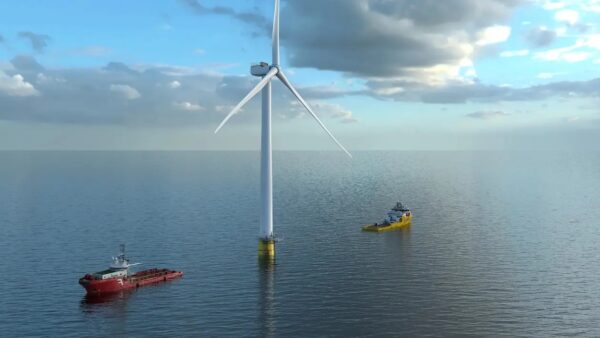After taking a final investment decision today, Denmark’s Dong Energy will build the giant Hornsea Project One offshore wind farm, capable of powering more than a million UK homes, off the coast of Yorkshire.
With a capacity of 1.2 GW, it will be the world’s first offshore wind farm to exceed 1 GW in capacity and will become the world’s largest offshore wind farm upon completion, scheduled for 2020.
It will have nearly twice the generating capacity of the world’s current largest, the 630 MW London Array, a 175-turbine farm located in the outer Thames Estuary (shown above) in the UK.
“It is ground-breaking and innovative, powering more homes than any offshore wind farm currently in operation,” said Brent Cheshire, Dong Energy UK’s country chairman.
The UK government agreed in April 2014 to pay Dong Energy a fixed price per MWh of electricity produced by Hornsea in its first 15 years of operation, after which the company will get the market price.
Dong Energy’s investment shows that we are open for business and is a vote of confidence in the UK and in our plan to tackle the legacy of under-investment and build an energy infrastructure fit for the 21st century– Amber Rudd, UK Secretary of State for Energy and Climate Change
The pricing schedule agreed then had the government paying £140/MWh in 2018-19.
Brent Cheshire added: “To have the world’s biggest ever offshore wind farm located off the Yorkshire coast is hugely significant, and highlights the vital role offshore wind will play in the UK’s need for new low-carbon energy.”
Planned for nearly a decade, Hornsea One will be located 120 kilometres off the Yorkshire coast. The farm will cover approximately 407 sq km, an area five times the size of the city of Hull. The offshore wind farm will use 7 megawatt (MW) wind turbines, with each one 190 metres tall – larger than the Gherkin office tower in London.
Siemens has been named preferred supplier for the turbines and the new Siemens turbine production facilities in Hull will support the project.
Dong said project has the potential to create around 2,000 jobs during construction, with up to 300 additional jobs supported directly and indirectly during its operational phase.
A £25 million contract has also been awarded to UK infrastructure company Balfour Beatty for the construction of the onshore substation.
“Dong Energy’s investment shows that we are open for business and is a vote of confidence in the UK and in our plan to tackle the legacy of under-investment and build an energy infrastructure fit for the 21st century,” said UK Secretary of State for Energy and Climate Change, Amber Rudd.
As part of the project, Dong Energy will construct the longest offshore wind farm high voltage AC electrical system in the world, featuring more than 900km of cables.
Dong Energy is the sole owner of Hornsea Project One after acquiring the 66.66% ownership share of SMart Wind in February 2015. Dong Energy also has the project rights to Hornsea Project Two and Hornsea Project Three, which have the potential of 3 GW of offshore wind power capacity in total.
Hornsea Project One is expected to be fully commissioned in 2020.
Photograph: The world’s current largest offshore wind farm is the London Array, shown here under construction in 2009 (William Hall/Wikimedia Commons)
Comments
Comments are closed.











What commitment have they given beyond the period of guaranteed subsidies from the UK government for the infinite period beyond the first 15 years , or will they just pack up and say thank you and no thank you?
Why is there no direct citizen investment allowed in energy any-more?
Are we not just creating more Amazon and Google in every sector of industry and enabling the rich to get richer while the poor get poorer? Something has to give sometime?
174 wind turbines, if instead of the planned “compact” formation were arranged in a giant ring formation, with the same spacing between wind turbines, could deliver about FOUR times more power and energy, in theory!
Wind farm power and energy equations
http://scot.tk/forum/viewtopic.php?t=603
“Dow” Equation for the power and energy output of a wind farm
“The power and energy of a wind farm is proportional to (the square root of the wind farm area) times the rotor diameter”.
It is of interest to compare the two formations of wind farm for the same n (number of turbines) and s (spacing).
The diameter of the ring formation is larger by the ratio of diameter formulas in which the spacing s drops out.
Ring formation diameter : Compact formation diameter
n/PI : 2 x SQRT (n/PI) – 0.9835
This ratio can be evaluated for any n > 3 and here are some ratios with the compact value of the ratio normalised to 100% so that the ring value of the ratio will give the ring formation diameter as a percentage of the equivalent compact formation diameter.
Here are some examples,
n = 4, 100 : 100
n = 10, 123 : 100
n = 18, 151 : 100
n = 40, 207 : 100
n =100, 309 : 100
n =180, 405 : 100
n =300, 514 : 100
n =500, 656 : 100
The ratio for n=174 would be 398 : 100, meaning that 174 wind turbines arranged in a ring formation is about 400% or 4 times wider than a compact formation, generating 4 times more energy and power!